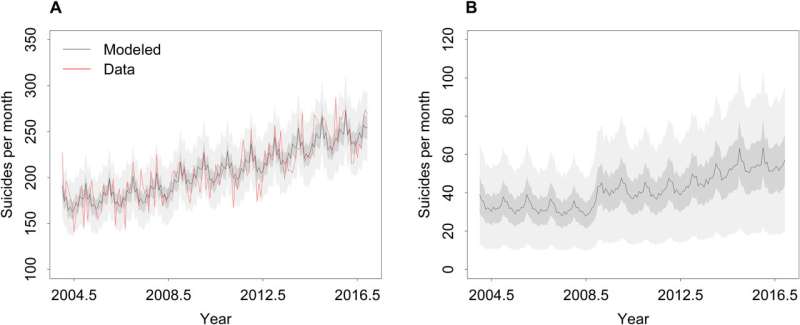This article has been reviewed according to Science X's editorial process and policies. Editors have highlighted the following attributes while ensuring the content's credibility:
fact-checked
peer-reviewed publication
trusted source
proofread
Unemployment and underemployment significant drivers of suicide: Analysis

A study examining unemployment and underemployment figures and suicide rates in Australia has found both were significant drivers of suicide mortality between 2004-2016.
The researchers say the findings indicate that economic policies such as a Job Guarantee, which prioritize full employment, should be a core part of any comprehensive national suicide prevention strategy.
Predictive modeling also revealed an estimated 9.5 percent of suicides reported during that time resulted directly from unemployment and underemployment.
The analysis used national data, which included numbers of suicides per month provided by the Australian Institute of Health and Welfare, and monthly unemployment and underemployment statistics from the Australian Bureau of Statistics.
The 13-year period includes the Global Financial Crisis (mid 2007 to early 2009) and the beginning of the Robodebt scheme (July 2016).
Between 2004—2016, approximately 1 in 10 of the 32,331 suicides in total were estimated to result from labor underutilization (3071 suicides or 9.5 percent).
1575 suicides were attributed to unemployment (4.9 percent of total suicide mortality). 1496 suicides are attributed to underemployment (4.6 percent)
The study, published in Science Advances, was led by researchers from the Brain and Mind Centre at the University of Sydney.
The results are consistent with epidemiological studies (independent of this study) that found changes from employment to unemployment tend to produce a significant increase in psychological distress.
"Our analyses provide evidence that rates of unemployment and underemployment were significant drivers of suicide mortality in Australia during that time," said lead researcher Dr. Adam Skinner from the Brain and Mind Centre.
"Ensuring adequate employment for every person seeking work is an effective way to reduce the immense personal and social cost of intentional self-harm and suicide."
The study used a relatively new analytical method called convergent cross mapping to confirm causal effects of underemployment and unemployment over time on suicidal behavior.
The strength of convergent cross mapping is that it allows researchers to detect cause and effect in complex systems, where significant correlation between variables does not necessarily indicate causality.
Predictive modeling was used to estimate the number of suicides caused by labor underutilization per month.
"The study confirms that a high priority in suicide prevention should be full employment, particularly as we now face economic uncertainty in Australia," said Brain and Mind Centre co-director, Professor Ian Hickie AM.
"Rising unemployment costs lives—particularly among those most vulnerable groups."
More information: Adam Skinner et al, Unemployment and underemployment are causes of suicide, Science Advances (2023). DOI: 10.1126/sciadv.adg3758

















